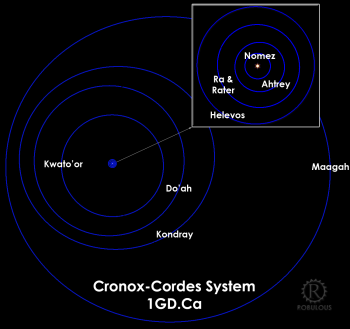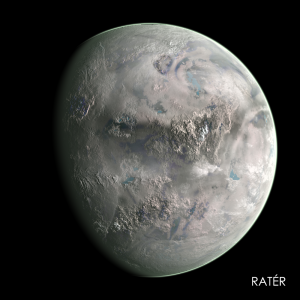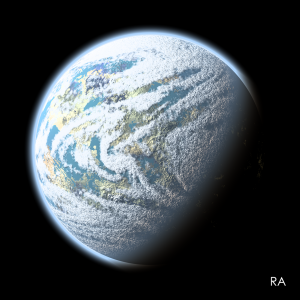Ra and Ratér
 Ra (RAH) and Ratér (rah-TAIR) are mutually-orbiting binary planets in the Cronox System. The two are both marginal for human life but were settled many millennia ago. Rivalry and conflict between the two throughout their history laid the foundation for a series of accords for mutual co-operation, which was the foundation for the Cronoxi Syndicate, the pan-stellar political institution which now governs the system.
Ra (RAH) and Ratér (rah-TAIR) are mutually-orbiting binary planets in the Cronox System. The two are both marginal for human life but were settled many millennia ago. Rivalry and conflict between the two throughout their history laid the foundation for a series of accords for mutual co-operation, which was the foundation for the Cronoxi Syndicate, the pan-stellar political institution which now governs the system.
Formation
The twin planets were most likely formed in the early solar system by a collision between two large proto-planetary bodies. The impacting body was large enough, and the collision so violent, that rather than forming one moon, it split the molten mass into two parts. These condensed into spherical bodies of roughly equal mass, which eventually settled into a stable orbit about a common point, or barycentre.
Although both worlds once rotated at their own rate, today their faces are forever tidally locked towards each other. The local day is therefore determined by their mutual rotation, giving the worlds an usual day-night cycle in which each day is the also a thirty-four standard-day month.
The climate of the two varies much more with hemisphere than with latitude. The outer-facing hemispheres of both worlds have a monthday of full, hot sun, followed by an equal period of cold, moonless night. On the inner faces, at night the world is lit by moonlight which waxes and wanes throughout the daymonth. During the day there is full sunlight, though not as hot as the spaceward side, since by this point in its orbit the planet is further away from the sun. Parts of each world's inner surface are eclipsed once a month, either totally or partially, by the companion world.
The twins have significant tidal effects on each other because of their size and close orbit, which makes them both more seismically active than would be normal for their small size, and contributes to the continued heat and magnetism in their rocky cores. Ratér has earthquakes but little volcanic activity, whereas Ra, the smaller, has more volcanic eruptions and numerous geysers due to its thinner crust. Despite these peculiarities, the twin worlds are the mostly densely inhabited worlds in the system. Their original interplanetary trade and cultural agreements were the beginning of the system’s regulatory body, the Cronoxi Syndicate.
Ratér

Ratér is grey-brown marginal desert world with a number of small landlocked seas. The modern surface has extensive sedimentary rock formations, contorted into massive gnarled ranges with deep canyons and networks of ancient river systems. In the primeval past it was much wetter, but over aeons of time the water has gradually leached away by solar activity, and by several violent impacts. It still has extensive underground water, in deep chasms, caverns and cool shadowed heights, so that life still exists, but most of the surface is arid desert rich in crystalline rock and sand. The predominant form of plantlife is a variety of colonial cyanobacteria which grow within rocks or in subsoil, though some grow to immense size as land-reefs, protected by a thin layer of sand.
Ratér was colonised by humans perhaps fifteen millennia ago. From the very first there were extensive efforts to make the planet more suitable for human life. The first societies managed to maintain a relatively high level of technology and culture, despite, or perhaps because of, the difficulties living on such a less=than-hospitable world presented. The bulk of the population now live in cities powered by geo-electrical energy or solar-power, many of them clinging to the walls of the many canyons and chasms which cross the planet, shielding the population from dust storms and giving access to the water welling up far below.
Ra

Ra is smaller than its companion, but has a thick moist atmosphere that makes it appear as a bright moon in Ratérs sky. The greenhouse effect is high but its cloudy white upper atmosphere reflects a great deal of the sun's energy, so that its entire surface maintains a remarkably constant temperature. About 40% of the surface is covered by sea, with high concentrations of mineral salts. Much of the land area is rolling hills covered with mega-leafed plant life, and microbes that feed on abundant chemical energy as well as photosynthesis. The majority of native fauna are slow herbivores, living in a relatively energy-poor environment, but there are some fierce predators particularly small crawling and flying reptiloids.
History
According to the most ancient tales and archeological evidence, Ratér (possibly meaning “sky-land”) was first colonised by humans approximately twelve millennia ago by settlers who had fled Vosplugin-autotooltip__small plugin-autotooltip_bigHelevos
Helevos (also known as Vos, or Veeos) is a temperate terrestrial world, fourth planet of the star Cordes in the Cronox binary star system. The stars Cordes and Arjos are distant binaries, so on Helevos, Arjos is only seen in the northern hemisphere as star, sometimes bright enough to be seen during the day, circling roughly over the viridgreenAnásthiasAnásthiasAnásthiasgreen, their mother world. According to legend they flew from Vos on a moon, which crashed into the surface and spilled human life onto its surface. Unlike the elders of Vos, the renegades wished to retain their high technology, which was essential for survival in the inhospitable environment of their new home.
There are many theories about the historicity of this founding myth, one being that early settlers may have used converted one of Helevos's “fixed stars” into a space vessel.
Over many centuries humans spread across the world, first covering whole canyons in glass to create a warm and moist environment, later using biotechnology to terraform the world and grow cities and infrastructure, particularly the vital network of water tubes which irrigates the planet.
Ra was colonised by settlers from Ratér millennia ago, but the early settlers very quickly “went native” once freed from the restrictions and dangers of their home world. Unlike on Ratér, on Ra it was possible for humans to wander freely, some early settlers going so far as to modify their own biology, enabling them to survive and prosper on the new world's various plant and animal life.
The authorities of Ratér built sealed cities of their own and tried to exert colonial control over Ra and what they considered its savage, backward people.
The two worlds had a long history of conflict. It was resolved centuries ago, with the two worlds agreeing mechanisms for mutual acceptance, trade and peaceful cooperation. This agreement became the basis of the Cronoxi Syndicate.
The Link
The twin worlds are linked by the biggest space elevator known to exist. Historically it was twice destroyed by terrorists from Ra who wished to end Ratér's colonial influence.
